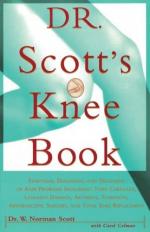|
This section contains 315 words (approx. 2 pages at 300 words per page) |
Joints are the connections, or articulations, between bones. Joints may be classified either structurally, by what material links the bones, or functionally, by how much movement is allowed in the joint. In common usage, the word "joints" generally refers to the freely moving joints with joint cavities. These are called synovial joints. However, some joints allow little or no movement between the bones. These joints may consist either of fibrous connective tissue or cartilage. Fibrous and cartilaginous joints may eventually turn to bone, or ossify, over time.
There are two types of cartilaginous joints. Primary cartilaginous joints are also called synchondroses. In these joints, which are always immovable, a plate of smooth, pearly hyaline cartridge connects the bones. Examples of these joints are the epiphyseal or growth plates at the ends of the long bones. These serve as bone-forming centers during growth, and ossify in adults.
The other class of cartilaginous joint consists of the secondary cartilaginous joints, or symphyses. In these joints, the surfaces of the bonds to be joined are each covered with a smooth layer of hyaline cartilage. The two hyaline cartilage layers are themselves joined by fibrocartilage, which contains thick strands of collagen fibers. The result is a sort of sandwich of cartilaginous material between the bones. The cartilaginous pad can be compressed and stretched, allowing limited movement at these joints.
There are a few especially important examples of symphyses in the human body, such as the pads between the vertebrae. These intervertebral discs have tough fibrocartilage around their rims and less dense, fluid-soaked centers. The discs serve as shock absorbers and provide flexibility in the spine.
The pubic symphysis joint in the lower pelvis is usually immovable. However, during pregnancy, hormone changes influence its structure and make it more flexible. This allows it to stretch so that the baby's head can pass through the birth canal.
|
This section contains 315 words (approx. 2 pages at 300 words per page) |


